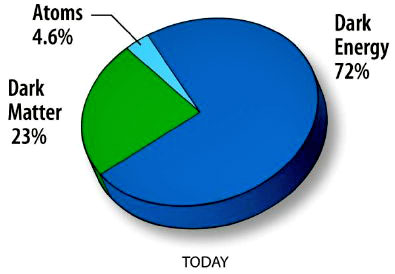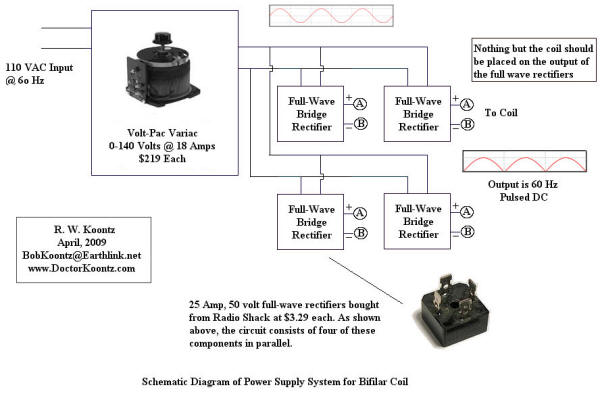|

by Robert Koontz
from
DoctorKoontz Website
"Whatever dark energy actually
is,
detailed measurements from independent techniques reveal
that
it comprises a whopping 72% of our universe's total
mass-energy.
(Credit: NASA and the WMAP
science team)"
Source
Dark Matter
There are two kinds of unknown matter-energy in the universe.
One of these is called
dark matter and
the other is called dark energy. Dark matter might just be
relatively ordinary matter that is just not emitting light. So,
burned-out stars might be contributing to dark matter. Or it could
be that dark matter is a form of matter associated with previously
unknown particles which have a large mass but do not otherwise
interact very strongly.
These hypothetical particles are called
WIMPS for weakly interacting massive particles. WIMPS have yet to be
seen, although experimental searches are underway.
Dark Matter is thought to contribute to about 23% of the mass of the
known universe. This dark matter appears to attract ordinary matter
and as such would be acting to decrease the expansion of the
universe. Dark matter would thus be gravitic rather than
antigravitic. Dark matter may possibly be totally unconnected with
dark energy, but this is not exactly known, only hypothesized about.
Dark matter also appears necessary to account for the fact that
galaxies do not fly apart even though the energy associated with
their angular motion exceeds their deduced gravitational (binding)
energy.
In essence, an attractive and unseen (dark matter) appears
necessary in order for things to work out when it comes to galactic
mechanics.
More on Dark Matter in below insert:
|
DARK MATTER
from
BBC Website
One of the biggest
conundrums in modern astronomy is the fact that over 90%
of the Universe is invisible. This mysterious missing
stuff is known as 'dark matter'.
The problem started when astronomers tried to weigh
galaxies. There are two methods of doing this. Firstly,
we can tell how much a galaxy weighs just by looking at
how bright it is and then converting this into mass.
The second way is to look at the way stars move.
Everything in the Universe rotates. The
Earth spins on its axis. The whole planet orbits
around our parent star, the
Sun.
The Sun rotates around
the centre of the Milky Way, along with the billions of
other stars in the Galaxy, forming a huge cosmic dance.
This rotation provides another way of weighing a galaxy.
Studying how fast stars at the very edge move reveals
the mass of the whole galaxy. The faster the Galaxy
rotates, the more mass there is inside it.
But when astronomers such as Jan Oort and
Fritz Zwicky did the two sets of sums in the early
1930s they hit a big problem. For every galaxy they
studied the two answers didn't match. They were very
confident that both methods were sound as they'd been
tried and tested for many years.
So they came to a
startling conclusion - there must be stuff out there
that we just can't see - and so they called it 'dark
matter'. This dark matter was really important, as if it
wasn't there then galaxies would fly apart as they spun
round.
This might seem like a strange conclusion, but it's not
really that bizarre. Imagine looking at a tower block at
night. Although you can only see lights coming from some
of the rooms, that doesn't mean that there aren't any
more rooms in the tower. Just like these unlit rooms,
dark matter can't be seen, because it doesn't shine.
Astronomers are currently
hunting for this missing matter. It may consist of lots
of strange sounding things like MACHOs, WIMPs and
neutrinos. Or there may be new solutions involving dark
energy or superstring theory.
But whatever it is,
finding it will help to answer one of the most
fundamental questions in astronomy - what is the
fate of the Universe?
|
Note: The hypothetical constituent elements of dark matter
are also sometimes referred to as MACHOS ... More On MACHOS
here.
Dark Energy
Dark energy is energy that appears to fill the universe and appears
to have an antigravitic nature in that it is thought to be pushing
the universe apart.
It is thus reasoned that the rapid rate of
expansion of the universe is a consequence of dark energy. But no
one as of yet knows what dark energy is. Some people think that dark
energy is a manifestation of Einstein's cosmological constant. This
would be associated with a very large negative energy density that
might be seen everywhere in space.
Einstein was the first to
introduce the cosmological constant when he was developing his
general theory of relativity and later said that this was his
greatest mistake. (Photo
Gives Weight to Einstein's Thesis of Negative Gravity)
73% of the mass-energy of the universe
is said to be related to dark energy.
See below insert:
|
NASA And DOE Collaborate On Dark Energy Research
http://www.sciencedaily.com/releases/2008/11/081119171826.htm
ScienceDaily (Nov. 25, 2008)
NASA and the U.S. Department
of Energy (DOE) have signed a memorandum of
understanding for the implementation of the Joint Dark
Energy Mission, or JDEM.
The mission will feature the
first space-based observatory designed specifically to
understand the nature of dark energy.
Dark energy is a form of energy that pervades and
dominates the universe. The mission will measure with
high precision the universe's expansion rate and growth
structure. Data from the mission could help scientists
determine the properties of dark energy, fundamentally
advancing physics and astronomy.
"Understanding the
nature of dark energy is the biggest challenge in
physics and astronomy today," said Jon Morse,
director of astrophysics at NASA Headquarters in
Washington.
"JDEM will be a unique
and major contributor in our quest to understand
dark energy and how it has shaped the universe in
which we live."
One of the most significant
scientific findings in the last decade is that the
expansion of the universe is accelerating. The
acceleration is caused by a previously unknown dark
energy that makes up approximately 70 percent of the
total mass energy content of the universe.
This mission has the
potential to clarify the properties of this mass energy.
JDEM also will provide scientists with detailed
information for understanding how galaxies form and
acquire their mass.
"DOE and NASA have
complementary on-going research into the nature of
dark energy and complementary capabilities to build
JDEM, so it is wonderful that our agencies have
teamed for the implementation of this mission," said
Dennis Kovar, associate director of the DOE Office
of Science for High Energy Physics.
In 2006, NASA and DOE
jointly funded a National Research Council study by the
Beyond Einstein Program Assessment Committee to assist
NASA in determining the highest priority of the five
proposed missions in its Beyond Einstein program.
In September 2007, the
committee released its report and noted that JDEM will
set the standard in precisely determining the
distribution of dark energy in the distant universe. The
committee recommended that JDEM be the first of NASA's
Beyond Einstein missions to be developed and launched.
Following the committee's report, NASA and DOE agreed to
proceed with JDEM.
The importance of understanding dark energy also has
been emphasized in a number of other significant reports
from the National Research Council, the National Science
and Technology Council, and the Dark Energy Task Force.
For more information about JDEM,
including the signed memorandum of understanding, visit:
http://jdem.gsfc.nasa.gov |
Can Dark Energy Be Produced In the
Laboratory?
It has been estimated that 72% of the
mass-energy of the universe consists of something that scientists
refer to as "dark energy," an energy that is known to be
antigravitic, a negative energy.
So, why, if that energy is so
prevalent, can't we produce it?
The answer may be that we can
produce it.

But we have to take a different approach
to how we think of energy.
The Bifilar Coil Used In the Experiments
The photo below shows the large bifilar coil through which 15 amps
of pulsating 60 Hz DC was passed.

In this bifilar coil, the current
flowing through one lead of twin-lead wire was redirected back
through the second lead so that the magnetic field of the second
lead canceled the magnetic field of the first lead.
It is this
canceling of electromagnetic fields which forms the basis of what is
called "scalar
electromagnetics."
While it appears to be the case that
scalar electromagnetics has been developed and exploited by Russian
weapons scientists, western physicists generally do not appear to
understand this form of physics. Many Western scientists may even
deny that scalar electromagnetics is possible.
The existence of scalar electromagnetics
would imply that classical electrodynamics is flawed, which is
something I have asserted is true and which is a relatively easy
proposition to prove.
|
Classical Electrodynamics is
Flawed
from
DoctorKoontz Website
TWO
CANCELING PHOTONS IN A BOX
WHERE DOES
THE ENERGY GO?

Consider two photons in a
box -- with the two photons 180 degrees out of phase.
The photons each carry one unit of energy, but because
they are 180 degrees out of phase, the electromagnetic
energy density is zero, as is the Poynting vector.
Therefore, if we follow
conventional reasoning, we have lost two units of energy
and thus have a violation of energy conservation. But
that is not allowed. We must thus deduce that classical
electrodynamics has a flaw within it.
That flaw is addressed when
we include scalar electromagnetic energy - as it has
come to be called.
|

The variac shown in the schematic may be purchased
here, the
full-wave bridge rectifiers
here.
The wire employed in the coil involved
five rolls or approximately 500 feet of
#16 Radio Shack speaker
wire.
Here is possible replacement wire:
link. Essentially the wire
was wound into loops of nylon cable ties that were fed through holes
drilled into a large piece of wood paneling turned upside down. The
current level at which the device was operated was set to the
maximum level at which the device could operate without overheating.
That was about 15 amps or so at about 15 volts.
Eventually, after years of operation,
the coil burned out.
Holes Produced In The Clouds?
When the device was operating at
maximum current levels, and with all sources of light turned off,
with the windows blocked, there appeared to be some sort of blue
ectoplasmic energy coming off the coil.
That energy appeared to fill the room in
which the coil was operating.
Since a large amount of energy was
apparently involved, and since the Soviets reportedly used scalar
energy in weather control, experiments were done to see if the
energy emitted by the bifilar coil would affect the clouds above the
house.

On several occasions, it was seen that
large holes were produced directly above the house, as can be seen
in the photo above where a contrail is evident through one of two
large holes.
Note: With respect to operation of the bifilar coil, it is
advisable to have a 2 or 3 inch air gap above and below the coil as
otherwise the coil is not in an ideal state for generation of the
scalar energy. The air gap also allows for air circulation. One of
course should be very careful to not overheat the system. Placing a
fuse in the primary of the variac is advisable. Be careful that you
do not cause a fire with this system. Careful engineering is
advised, as one should be careful to operate the system only when a
person is present.
Also: When winding the coil, try to not introduce any twists
in the twin-lead wire.
And based on a calculation I have done, a better frequency for
pulsing the system might be 4.8 Hz, rather than 60 Hz. But that
would be more difficult to engineer. So I would suggest first
building the device I built and to then go from there.
Another thing: Do not place a voltmeter or any other device
across the output of the rectifier circuits. Nor should an ammeter
be place in series with the coil. Connect the output of the
rectifier circuits directly to the coil with nothing else involved.
If this is not done, then there is the very real risk that the
system will not produce the desired energy. Do not ground either
side of the coil. Let the system float.
Health Effects With This Energy: I have found that the
experience of the putative dark energy produced by the bifilar coil
above is very pleasant. But it does appear that one can get too much
of a good thing, for after exposing myself to the energy for many
hours, I did find myself very tired. Those who experiment with this
energy are advised to proceed cautiously, and, of course, you are on
your own.
But my experience with this energy is
good.
Videos
Study Sheds Light On Dark Energy
Dark Energy and the Runaway Universe
Patricia Burchat: The search for dark energy and
dark matter
|





